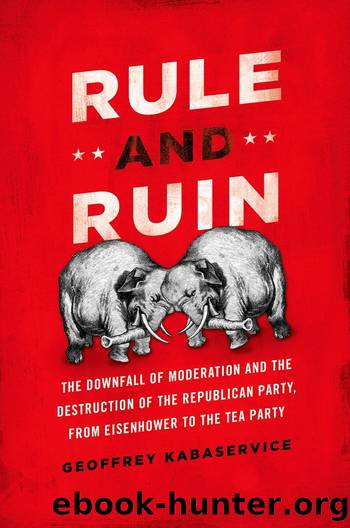Rule and Ruin by Kabaservice Geoffrey

Author:Kabaservice, Geoffrey
Language: eng
Format: epub
Tags: The Downfall of Moderation and the Destruction of the Republican Party
Publisher: Oxford University Press, USA
Published: 2012-08-14T16:00:00+00:00
CHAPTER 9
Some Revelation Is at Hand
Richard Nixon’s First Year in Office, 1969
During his long political career, Richard Nixon inspired countless attempts to determine his ideological and psychological identity. Was Nixon a liberal, a conservative, a moderate, or none—or all—of those things? Were there discernable principles and ideals at his core, or an echoing void, or a writhing mass of darkness? There can be no definitive answer to the quest for the “real” Nixon, but perhaps the best one-word description of him is: Republican. No one better personified the party’s varied elements, its internal struggles and contradictions, its noble ideals and sordid impulses, its bright hopes and bitter resentments. For many of the delegates at the 1968 GOP convention, it was Nixon’s emphasis on party unity, and his ecumenical willingness to campaign for Republicans of every stripe over the course of two decades of party service, that made him the logical choice as the presidential nominee. As a campaigner, Nixon was uniquely able to straddle the moderate and conservative factions within the GOP, and as President he would continue to offer something to each group. While moderates and progressives would enjoy only partial successes during his presidency, Nixon made sure that they had what he characteristically referred to as “a piece of the action.” At the same time, Nixon both deliberately and inadvertently laid the groundwork for the decline of the Republicans’ moderate wing.
Moderates applauded many of Nixon’s early appointments. The Ripon Society saluted Nixon’s choice of White House advisors, particularly his designation of longtime Rockefeller associate Henry Kissinger as national security advisor and Kissinger’s Harvard colleague, Daniel Patrick Moynihan, a Democrat who had served in Lyndon Johnson’s administration, as urban affairs counselor. Ripon predicted that Moynihan would have “the critical creative functions” in the administration and would be a bridge to the “new liberals,” i.e., the neoconservative Democrats whom moderate Republicans generally viewed as allies. Ripon anticipated that centrists Melvin Laird at Defense and Robert Finch at HEW, the two youngest members of the cabinet, were also “likely to be the two most powerful” and might vie to succeed Nixon in 1976.1 Secretary of State William Rogers was a respected moderate who had served in the Eisenhower administration; the same description fit Nixon’s advisor for Congressional relations, Bryce Harlow, and the new assistant secretary of state, Elliot Richardson. Curiously, quite a few moderates were suspicious of John Volpe at Transportation and Walter Hickel at Interior. Though both men had a reputation as moderate governors of Massachusetts and Alaska, respectively, many feared that Volpe, a building contractor by trade, would swathe the American landscape in concrete while frontiersman Hickel would turn over public lands to private profiteers.2 Ripon hoped that the third governor in the cabinet, George Romney, would “turn out to be the most interesting appointment of all, for he is the most outspoken member of the cabinet, the one least likely to play the team game at all costs.”3
James Farmer’s appointment as assistant secretary of HEW and Arthur Fletcher’s
Download
This site does not store any files on its server. We only index and link to content provided by other sites. Please contact the content providers to delete copyright contents if any and email us, we'll remove relevant links or contents immediately.
| Anarchism | Communism & Socialism |
| Conservatism & Liberalism | Democracy |
| Fascism | Libertarianism |
| Nationalism | Radicalism |
| Utopian |
The Secret History by Donna Tartt(16618)
The Social Justice Warrior Handbook by Lisa De Pasquale(11489)
Thirteen Reasons Why by Jay Asher(7786)
This Is How You Lose Her by Junot Diaz(5768)
Weapons of Math Destruction by Cathy O'Neil(5034)
Zero to One by Peter Thiel(4823)
The Myth of the Strong Leader by Archie Brown(4789)
Promise Me, Dad by Joe Biden(4444)
Stone's Rules by Roger Stone(4415)
Beartown by Fredrik Backman(4413)
How Democracies Die by Steven Levitsky & Daniel Ziblatt(4397)
The Fire Next Time by James Baldwin(4341)
100 Deadly Skills by Clint Emerson(4076)
A Higher Loyalty: Truth, Lies, and Leadership by James Comey(4031)
Rise and Kill First by Ronen Bergman(4012)
The David Icke Guide to the Global Conspiracy (and how to end it) by David Icke(3881)
The Farm by Tom Rob Smith(3871)
Secrecy World by Jake Bernstein(3782)
The Doomsday Machine by Daniel Ellsberg(3730)
